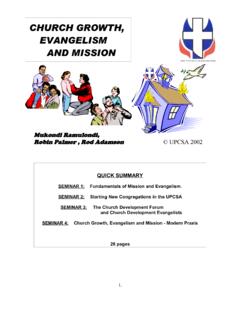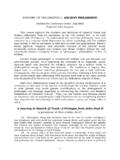Transcription of Unleash the Gospel - St. James Catholic Church
1 1 Unleash the Gospel Contents 1. INTRODUCTION ..2 2. FOUNDATIONAL CONVICTION ..3 3. CATECHETICAL EXPOSITION ..4 4. GUIDEPOSTS ..10 Guidepost 1 The New Pentecost ..10 Guidepost 2 With Eyes Fixed on Jesus ..13 Guidepost 3 The Word Made Flesh ..15 Guidepost 4 Equipping for the Service of the Gospel ..18 Guidepost 5 No Bystanders ..20 Guidepost 6 Person-to-Person Engagement ..22 Guidepost 7 Families ..24 Guidepost 8 Attraction ..26 Guidepost 9 Encounter, Grow, Witness ..28 Guidepost 10 Calling Upon the Advocate ..29 5. PROPOSITIONS AND ACTION STEPS ..30 FAMILIES ..32 PARISHES ..34 ARCHDIOCESAN CENTRAL SERVICES ..36 6. CONCLUSION ..40 2 1. INTRODUCTION When the time for Pentecost was fulfilled, they were all in one place together. And suddenly there came from the sky a noise like a strong driving wind, and it filled the entire house in which they were. Then there appeared to them tongues as of fire, which parted and came to rest on each one of them.
2 And they were all filled with the Holy Spirit and began to speak in different tongues, as the Spirit enabled them to proclaim. Acts 2:1-4 Jesus Christ makes all things new! He himself is at work to renew his Church in the Archdiocese of Detroit. He is pouring out his Holy Spirit anew so that every member of the Church may be formed and sent forth as a joyful missionary disciple, so that the Gospel may be unleashed in southeast Michigan. Just as in the Upper Room at Pentecost, it is the Holy Spirit who transforms Christ s disciples from ordinary people into Spirit-filled evangelizers. Before the coming of the Spirit, the early Christians did not seem a particularly impressive group of people. They had good reason to be filled with fears, concerns, and feelings of inadequacy as they contemplated the awesome task Jesus had given them: to be his witnesses to the ends of the earth. They were still struggling to comprehend the events of recent days: the crucifixion, resurrection, and ascension of the Lord.
3 But when the Spirit fell upon them, their hearts were set ablaze with the fire of God s love and they could no longer keep the good news of Christ to themselves. They went out from the Upper Room overflowing with the joy of the Gospel . Through their witness, the Gospel was unleashed in Jerusalem and from there throughout the ancient world. Today no less than two millennia ago, there is no limit to what the Lord can do in our midst. His part is to clothe his Church with power from on high (cf. Luke 24:49) for the accomplishment of her mission. Our part is to give him our wholehearted yes to let ourselves be transformed, guided, and sent forth by the Holy Spirit, who is the principal agent of evangelization. 1 Over the last three years we, God s family in the Church of Detroit, have already been experiencing a spiritual renewal as we have prepared and strategized for a missionary transformation of the Archdiocese. It began in March of 2014 with my announcement of a year of prayer for a new Pentecost.
4 During that year the whole Archdiocese was united with Mary, the Twelve, and the other disciples in the Upper Room, praying for and expectantly awaiting a new coming of the Holy Spirit. People from all over the Archdiocese began to tell me of signs that this prayer is being answered. In 2015-2016 the Come, Encounter Christ! missions held around the Archdiocese with Eucharistic adoration, spirited music and preaching brought many into a renewed encounter with Jesus. In April 2016 the Amazing Parish Conference provided a powerful impetus for local parish leaders to reimagine and fortify the mission-centered focus of our parishes. Throughout 2016 parishes across the Archdiocese hosted parish dialogue 3 gatherings, in which parishioners freely expressed their hopes, concerns and suggestions for the Church in Detroit. A profoundly significant step along this itinerary was the Mass for Pardon on October 7, 2016, in which I came before God with my fellow priests and hundreds of lay people to repent on behalf of the Archdiocese for the sins committed over the generations by our bishops, priests, lay ministers, institutions, and all the faithful sins that all too often had become embedded in our Church culture.
5 Asking and receiving God s forgiveness for the failings of the past enables us to move forward with new hope and courage. Finally, the archdiocesan-wide Synod 16, held November 18-20, 2016, was an historic occasion during which representatives from all corners of the Archdiocese clergy, religious and lay people gathered to pray and reflect together on what will make the Church in southeast Michigan a joyful band of missionary disciples. The Synod was the ignition spark that is to set the Archdiocese ablaze. Its goal was nothing less than a radical overhaul of the Church in Detroit, a complete reversal of our focus from an inward, maintenance-focused Church , to an outward, mission-focused Church . This pastoral letter is to serve as the charter for implementing the fruit of Synod 16. The letter includes a statement of our foundational convictions (Part 2), an explanation of the basis in Catholic teaching for the Church s missionary focus, and a reading of the signs of the times in our part of the world (Part 3).
6 Parts 4 and 5 are the heart of the letter. Part 4 is a series of ten guideposts, each with some specific markers, to guide our implementation of the Synod. Part 5 lists the specific propositions and action steps that, following the recommendations of the Synod, we will take in order to become a missionary Church . Finally, in Part 6, I reaffirm that unleashing the Gospel is the work of the whole Church in the Archdiocese empowered by the Spirit of the risen Lord, and I describe how I aim to lead us in this mission in my remaining years as Archbishop. 2. FOUNDATIONAL CONVICTION It is [Christ Jesus] whom we proclaim, admonishing everyone and teaching everyone with all wisdom, that we may present everyone perfect in Christ. Colossians 1:28 The Synod s foundational conviction is that the Church in the Archdiocese of Detroit is resolved to obey the Holy Spirit and be made by him a band of joyful missionary This means that the Archdiocese, following the call of Pope Francis, is resolved to undergo a missionary conversion, a change in our culture, such that every person at every level of the Church , through personal encounter with Jesus Christ, embraces his or her identity as a son or daughter of God and, in the power of the Holy Spirit, is formed and sent forth as a joyful missionary disciple.
7 For families this means that every family embraces its role as the domestic 4 Church and, in connection with other families and single persons, actively seeks the spiritual and social renewal of its neighborhood, schools and places of work. For parishes and archdiocesan services it means the renewal of structures to make them Spirit-led and radically mission-oriented. For everyone in the Archdiocese it entails making one s relationship with Jesus and alignment with his will the central guiding principle of every aspect of life. This missionary conversion entails a strikingly countercultural way of living grounded in prayer, Scripture, and the sacraments; unusually gracious hospitality; a capacity to include those on the margins of society; and joyful confidence in the providence of God even in difficult and stressful times. 3. CATECHETICAL EXPOSITION Go, therefore, and make disciples of all nations, baptizing them in the name of the Father, and of the Son, and of the Holy Spirit, teaching them to observe all that I have commanded you.
8 Matthew 28:19-20 The missionary conversion to which the Lord calls us is new, yet it is also a return to the roots of our identity as the Church of Jesus Christ, manifested to the world on the day of Pentecost. It is the Church becoming young again! It is a reawakening to our foundational calling, applied in a new way to the specific circumstances and challenges of our time. The Missionary Nature of the Church The very last words Jesus spoke to his disciples before he ascended into heaven were the commission to evangelize all people: Go into the whole world and proclaim the Gospel to every creature (Mark 16:15).3 This mandate defines the Church for all time. As Blessed Pope Paul VI wrote, Evangelizing is in fact the grace and vocation proper to the Church , her deepest identity. She exists in order to evangelize. 4 Evangelizing is therefore a responsibility not only of bishops, priests, and religious, but of every individual Christian.
9 Evangelization is, very simply, proclaiming the good news of Jesus to those around us. This proclamation is to be both in word and in If we share the good news of Christ s love in words only, not demonstrably living what we preach, people will rightly suspect us of hypocrisy, and we may even give Christianity a bad name. On the other hand, if we share the good news in deeds only, people will not learn of the One who is the source of the joy and divine love we carry within us. Those around us are thirsting for the Gospel , the words of eternal life, even if they do not realize it. How can we fail to share generously what we have freely received? Over the centuries, as the Church became accustomed to existing within almost entirely Christian societies, it became all too easy to lose sight of Christ s mandate. Parishes and dioceses slipped almost imperceptibly into a mode of maintenance rather than mission. Many Catholics came to think of evangelization as a special calling, primarily for priests and religious in the foreign missions.
10 But in the last half century, even as the western world has become increasingly 5 secularized and countless people have abandoned the faith into which they were baptized, the Church has been ringing out a call for all Catholics to awaken to their baptismal identity as missionary disciples. All are being summoned to engage in a new evangelization a renewed proclamation of the good news of Christ to the people of our time. The term new evangelization, coined by Pope St. John Paul II, takes account of the fact that the Church in our time exists in a vastly changed situation. It is not that the Gospel has changed, but that we are called to a renewed effort that is new in its ardor, methods and expression. 6 The new evangelization is directed not only to those in distant lands who have never heard the Gospel , but to those around us in our own post-Christian society. The new mission territory is our own neighborhoods, workplaces, schools, and even our own homes.








